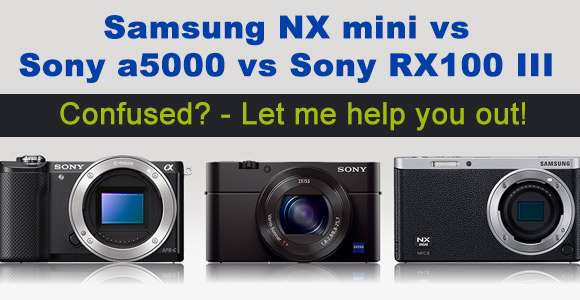
In this article I will compare three popular cameras. the first is Sony NX mini which is an interchangeable lens mirrorless camera, and the second one is a fixed-lens compact zoom camera, the RX100 III. The third one is the Sony Alpha a5000, which is a APS-C mirrorless camera. The first two cameras use a 1″ BSI-CMOS sensor, a relatively large sensor when compared to the conventional 1/2.3″ sensor found on many compact point-and-shoot cameras. Large-sensor cameras get the most attention lately, as they offer a good balance between portability, features and image quality. For some of you, one of those cameras can actually replace a DSLR camera. In this article we’ll take a closer look at the key features of each camera and learn about the differences, cons and pros as well.
I hope that after reading this Samsung NX Mini vs Sony RX100 III (RX100M3) vs Sony a5000 comparison, you’ll be able to make a more knowledgeable buying decision.
Samsung NX mini
Announced on March 19th 2014, the Samsung NX mini is a slim and compact mirrorless interchangeable lens camera. It actually looks more like a point-and-shoot camera than a conventional ILC camera. The mini also features a new NX-M lens mount, which means that the NX mini has its own range of NX-M interchangeable lenses. Those lenses are only compatible with the NX mini camera and future models to come.
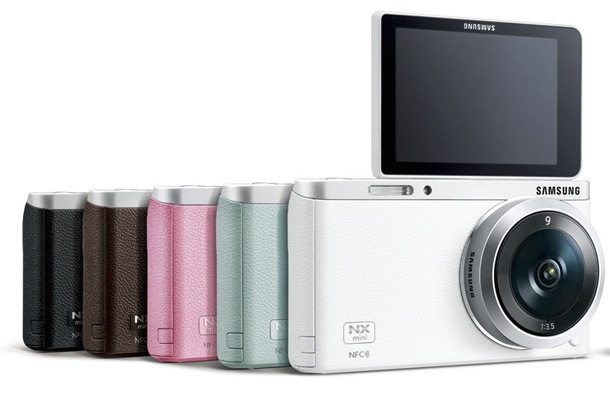
At the day of launch, Samsung introduced three new NX-M lenses, including a 9mm F3.5 (24.3mm equivalent) prime lens, 9-27mm (24.3-72.9mm equivalent) normal zoom lens and a 17mm (45.9mm equivalent) prime lens.
At the hear of the NX Mini is a 1″ (13.2 x 8.8 mm) 20.5 MP (effective) BSI CMOS sensor. This is the same sensor size as the Nikon 1 system cameras (i.e. Nikon 1 V3). This sensor is significantly smaller than APS-C

As you can see from the above comparison illustration, the 1″ sensor is smallest among the other popular sensor sizes found on most of the other mirrorless cameras, including those of the Samsung NX ILC which utilize a APS-C sensor. By using a smaller sensor, Samsung was able to create a smaller ILC body and lenses, so the overall size of the camera and lenses were marginally reduced compared to its NX cameras.
The Samsung NX mini body design looks quite plain and simple, and obviously designed like that to attract beginners. those whom might be intimidated by a camera with lots of buttons and dials.
At the back of the camera there is a 3″ 460.8k dots tilting (180 degree tilt for selfie / self-portrait shots) capacitive touchscreen. The mini lacks an eye level viewfinder. Yet, even with the rear LCD tilting mechanism, the mini maintains a very slim profile, considerably slimmer than the RX100 III and a5000, but it’s a bit taller and wider than the RX100M3.
I think that more people will care of the camera being slimmer, so they will be able to put it in their pocket. Having said that, once you mount an interchangeable lens on this camera (which you will of course), it won’t be pocketable anymore, depends on the lens you use. For example, if you intend to buy the 9mm lens, you will probably be able to put it in a pants’ pocket without any issues. However, if you intend to use the 9-27mm lens, you lose that portability, as the NX mini is significantly longer than the 9mm pancake lens.

Among the other key feature are :1/16000 sec. maximum shutter speed and 4 min. bulb, ±3EV exposure compensation, AE lock, 6fps burst shooting and up to 30 fps burst at 5MP (reduced resolution). The camera does have a small buil-in pop-up flash with 4.9 guide number,
The NX mini has a proprietary flash connector on top behind a rubber flip cover, which you can use to attach the SEF-7A external flash (optional).
The mini has lots of range of effects and shooting modes to play with, including 4 types of smart filters, picture wizard, Dynamic range expansion, 8 different shooting modes, including full manual mode and Wi-Fi mode.
The NX mini can shoot Full HD videos at 30 fps in MP4 (H.264) format with mono sound. The camera does feature Wi-Fi and NFC wireless connectivity, and you can use the camera with the Smart Camera 3.0 app to auto share, backup photo, transfer photos to mobile devices or use your phone as a remote viewfinder.
The Samsung NX mini was designed for those who search for a portable, compact and slim interchangeable lens camera that have full manual control, wireless connectivity to easily share photos between your camera and phone. The lenses will provide you with more composing creative flexibility, and the 1″ sensor should result in better image quality and low-light performance (compared to a conventional P&S compact camera).
* video by JimsReviewRoom youtube user
The Samsung NX Mini have received very good rating in most of the popular camera and gadget review websites. Many of those mentioned that they liked the small size and build quality, image and video quality was good, the touchscreen was responsive and the price was decent.
On the negative side, some reviews have mentioned that its a bit risky to try a new camera system, ad it might not exist in the future due to lack of demand. Others weren’t happy with the screen’s visibility in bright daylight and limited number of controls.
I personally wouldn’t worry that much about jumping into a new camera system. I think that the NX mini will stay here enough for you to enjoy it to its fullest, and most of you probably will be fine with only one or two lenses, so I wouldn’t worry about that either. Furthermore, this type of camera wasn’t designed in my opinion to carry a long telephoto-zoom lens. People should use it like an advanced / premium compact camera, and using a long lens will kill its portability. I think that Samsung did a smart move releasing the 9mm and the 9-27mm lenses as the first range of lenses. Those lenses are of very high quality, including tempered glass coating that helps to prevent scratches on the front elements of the lens.
The 9mm lens for example features 1 aspheric lens, 1ED lens elements and 1 Extereme High refractive lens. It was designed to offer spectacular optical performance.
All in all, the Samsung NX Mini is a cute, stylish little camera with enough features embraced with simplicity. The NX Mini will definitely attract both novice and advanced photographers, searching fora portable mirrorless camera for a good price. The camera is has magnesium body available in five different colors: black, brown, pink, cyan and white. The NX mini can be charged using the supplied mini USB cable wall charger. The mini works with microSD cards.
Sony RX100 III
The Sony RX100 III replaces the RX100 II. The RX100 series got lots of positive reviews and many awards. It’s in many photographer’s opinion, one of the best, if not The best compact camera on the market. In each generation Sony adds some new improvements, and the RX100 III is in my opinion, the most evolutionary among three.
Sony really wanted to make this camera stand out among all the other premium compacts, and as you’ll soon see, the RX100 III have a lot to offer, and it will certainly will make your decision much harder than you expected.
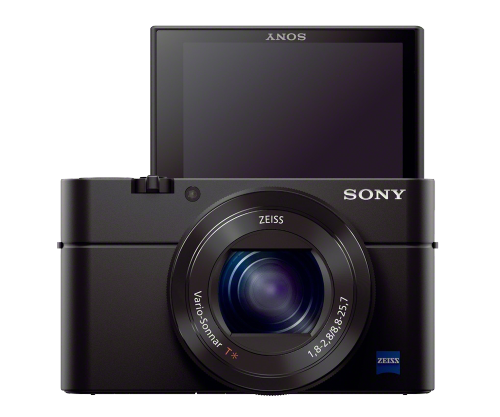
I know that many of you are turn between buying a large-sensor fixed-lens compact or go with a compact system camera. The RX100M3 is in my opinion, one of those camera that can convince many people to dump the interchangeable lens camera dream and stay with a fixed-lens camera instead. This camera of course has to offer some unique and useful features that will make it worthwhile among mirrorless cameras.
The RX100 III features the same exact 1″ 20.1MP Exmor R BSI-CMOS sensor, and roughly the same look and feel as its predecessor (there are some changes that I’ll talk about soon).
This sensor already proven to offer exceptional image quality in daylight and also very good low-light performance. So what could Sony do to improve upon this? — well, there are a few things. First of all, the new RX100 III feature a new 24-70mm (equivalent) F1.8-2.8 Carl Zeiss Vario-Sonnar lens with SteadyShot lens-shift image stabilization and 5-axis stabilization for video recording. The RX100 III also uses Sony’s latest Bionz X image processor, that offers improved noise reduction algorithms and faster performance overall.
So although Sony did shorten the focal length (zoom) range from 28-100 mm (3.6x zoom) to 24-70mm (2.9x zoom), it did give us a much faster lens, a wider lens (24mm vs 28mm ) and also used more advanced optical construction with cemented aspherical lens elements (world’s first). For a complete comparison, visit my RX100 III vs RX100 II comparison review. The new lens also provides shorter focusing distance for normal range (30cm vs 50cm).
Some will argue whether it was wiser to lower the optical zoom from an already limited zoom range. I think that most people will find this zoom to be well adequate for most of their needs, and a wider angle will give you more creative freedom when shooting indoors, landscape, group shots or even selfies. Even for a travel camera, I think that the having a wider and faster lens is preferable and well worthy upgrade over the RX100 II lens.
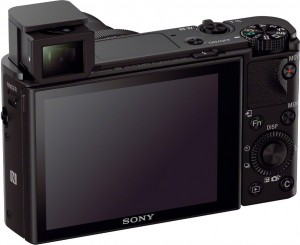
The next feature is one of my personal favorite among those introduces in the new model. Listen well! — The RX100 III feature a built-in pop-up viewfinder, and not cheap EVF, but a 1440K-dot OELD viewfinder, one that actually provided good view of the scene and doesn’t look like a tiny hole as with most the conventional compact point-and-shoot cameras. Because it has a pop-up mechanism, the viewfinder itself doesn’t take up of the vertical and horizontal space when it’s retracted in. The RX100 III therefore still maintain it’s portability, and the EVF will take a small amount of space at the top and rear when popped out.
Among the other interesting features are: 3″ 180-degree selfie-ready tilting LCD display, built-in ND filter (3 stops), HDMI clear output for uncompressed video recording, Wi-Fi and NFC wireless connectivity with mobile devices, PlayMemories camera apps compatibility, sweep panorama, built-in HDR, 10 fps burst in full resolution and lots of filter and effects to experiment with.
Sony didn’t improve upon its 25 AF points autofocus system, and you’ll get the same AF system as well. Furthermore, Sony also dropped the Multi-Interface connector from the previous model, so you don’t have any option to mount an external flash or connect an external microphone. I think that most people wouldn’t be using them anyways, as this camera was designed to be taken in the pocket.
The RX100 III improves upon the video functionality. It offers Full HD video recording at 60p, 30p and 24p with stereo sound, and also the option to record videos using Sony’s XAVC S (50 Mbps) coded, which offers improved image quality, but also takes more space. Keep in mind that in order to record videos using the XAVC S video format, you’ll need to use a SDXC card with Class 10 or higher speed.
The Sony RX100 III offers tones of advanced features, scene modes, exposure settings and picture effects to play with. The RX100 III is fast and responsive. It’s a camera that pros take in their pocket when they can’t or don’t want to carry their heavy DSLR camera, or as a second camera they can take everywhere they go.
The main target audience for this camera is casual photographers whom are looking for a compact camera that can take high quality photos, has advanced features and manual control over exposure, have great optics and features that will satisfy their enthusiast crave for capturing creative photography moments and memories.
The RX100 III will also appeal to novice photographers as well. The RX100M3 features many auto modes and effects which makes it easy to get gorgeous photos every time. You don’t need to be a pro nor to have lots of knowledge how to operate an advanced camera. Just put the RX100 III on one of its auto modes and let the camera do the rest. You’ll get home with much better looking images and you’ll be able to share those with friends and family. If you find yourself very limited with your camera phone capabilities, it’s time to give the RX100 III a try, it won’t disappoint you.
I also think that the RX100 III is a well-worthy upgrade to the RX100M2 and certainly from the RX100 Mark I.
Sony Alpha a5000 (Alpha 5000)
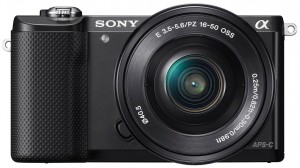
The Sony a5000 is Sony’s new entry-level mirrorless interchangeable lens camera. It was designed to compete against some other entry-level DSLR camera and offer a food alternative for those who both those whom are making their first steps in the ILC world and those whom searching for a cost-effective DSLR alternative.
The a5000 is a host for some a wide range of great features. It features a 20.1MP large APS-C Exmor sensor. This sensor is significantly larger than the 1″ sensor of the RX100 III, yet the camera itself is compact and slim. Having said that, due to the large sensor size, many of the Sony E-mount lenses are noticeably larger compared to mirrorless cameras that use smaller sensors, including the Micro Four Thirds and NX-M mounts. Sony does offer a few small and lightweight pancake lenses, and even some relatively very small normal zoom lenses as well.
Sony is not really into convincing people to see the a5000 as a pocket ILC camera, but rather a camera that is half the size of an entry-level DSLR and offers a roughly equivalent (if not better) image quality and performance.
The a5000 features Sony’s latest BIONZ X processing engine and Sony’s Ultra-fast AF, although the a5000 only employ a contrast-detect AF, not a Hybrid (contrast-detect AF + phase-detect AF). The lack of phase-detection AF should reduce the camera’s subject tracking AF capability for both stills and video recording (compared to hybrid AF setup).
At the back of the camera you’ll find a 3-inch 180-degree tilting LCD display for easy self-portraits. The camera can record Full HD videos at 60i (interlaced frames, not progressive frames = higher image quality) and 24p (cinematic frame rate). Among the other features are: built-in pop-up flash, PlayMemories apps compatability, 4 fps continuous shooting speed, Wi-Fi and NFC wireless connectivity to instantly connect to smartphones and tablets for sharing photos.
Like all alpha cameras, the a5000 is rich with software-based features, including a photo creativity feature, superior auto mode, lots of picture effect modes, auto object framing mode, hand-held twilight mode, etc. Novice photographers will find the a5000 very convenient and easy to use, regardless of its advanced controls.
http://www.youtube.com/watch?v=KXCnpQNbZ2Q
One of the reasons people opt for APS-C cameras, whether a DSLR or mirrorless, is the ability to achieve shallower depth of field (depends on the lens) compared to small-sensor cameras with equivalent focal length, and also given a superior low-light performance, that prevents them to shooting at High ISO which leads to more image noise. To picking an APS-C based camera is a good choice if you care about about those two advantages.
If you are searching for an entry-level mirrorless camera that offers easy wireless sharing, tiltable display for selfie-shots, big sensor for high image quality and all this in a small and slim camera body — the a5000 should be at the top of your list.
NX Mini vs RX100 III vs A5000
In this section I will compare the specs and feature of the NX mini vs those of the RX100 III and a5000. Keep a closer look at the features that you care about most. It’s easy to eliminate a camera when you know exactly what you are looking for, or only individual features that you know that you want or must have in your new camera.
[table id=153 /]
Conclusion
I think that many people who opt to buy one of these cameras give a great deal of attention to the camera size, wireless capabilities, photo editing / filters, image quality and manual controls. I think that what makes the Sony Cyber-shot RX100 III stand apart from the rest. It’s a camera that you can take everywhere you go. You can put it in your pocket and take it out when an opportunity comes for a great shot. You don’t need to worry about changing lenses, as you already have a very bright lens with versatile optical zoom range.
Although the RX100 III has the same sensor size as the NX mini, it offers better high ISO performance and very close performance of the a5000 APS-C sensor, which is very impressive. You also get a built-in EVF, excellent optics, advanced video and wireless functionality.
So why should you consider getting a mirrorless camera, either the NX mini or the Alpha 5000? — Well, both the NX mini and Sony Alpha 5000 have various advantage over the RX100 III, this includes: the ability to mount interchangeable lenses (inc. special lenses), better low-light performance (a5000 larger sensor and the ability to use faster lenses) and longer battery life (a500 and NX mini), faster maximum shutter speed (NX mini). I think that having to mount lenses is the main advantage that you get with ILC, including the ability to keep your lenses and upgrade to a better model in the future.
I think that most people just want to be able to capture special moments in high image quality, and therefore the portability plays a significant role here. The NX mini is somewhat between the a5000 and the RX100 III. If it weren’t for its size, I think that most people would consider buying another ILC camera instead. Having said that, the NX mini maintains its portability as long as you use the 9mm lens. Once you use the 9-27mm lens, it losses its portability, and therefore it equivalent to all the other compact system cameras out there portability-wise.
So in that respect, I think that it’s nice that Samsung created a smaller ILC with its own mount and small lenses, but I find it hard to justify getting it over, let’s say, the Alpha 5000 only for its sheer size. It also currently have limited range of lenses compared to other compact system cameras, and I think that’s currently the main Achilles heel of this NX-M system right now. On the positive side, it offers an excellent balance between size, performance and image quality. It’s 9mm lens doesn’t have a lens cap which also bother me some.
I personally would have gone with the RX100 III if you care about portability and don’t want to change lenses and fine with its weaknesses. I would go with the a5000 if you search for an ILC camera on a tight budget, but want a camera that already has a good range of interchangeable lenses to choose from. I would buy the NX mini if you want an ILC camera and want it slim and compact, and don’t mind leaving with its current limitations and intend to only use one lens or two for time being. With more lenses introduced, the NX mini would become a better system to jump into, and I am sure that the size of the lenses will appeal to those who like move light. However, right now, I find it hard to recommend it, although that as a whole, it offers a rich set of features, very good image quality and excellent battery life.
So it’s your choice now.
Which one you prefer? — share your opinion by leaving a comment in the comment section below.